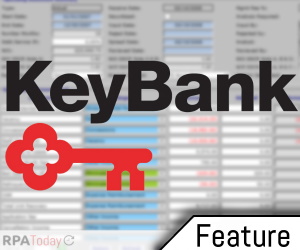
At KeyBank, digitization is all about simplifying services and processes. Digitization can take the form of process re-engineering, extending applications used, and/or RPA.
“The more we digitize, the more seamless the experience is for all stakeholders,” says Dominic Cugini, Senior Director of KeyBank Technology Operations and Services (KTOS) Service Digitization. “For our team members, we are reducing inherent risk and eliminating repetitive and non-client-centric activities, enabling them to focus on more value-added work. For our clients, we are reducing friction to improve their client experience.”
Early RPA: A Toe in the Water
KeyBank started its robotic process automation (RPA) journey in 2017 with a pilot program comprised of 45 federated RPA-trained staff. The pilot program demonstrated that automation could be a vital part of Key’s effort to “Digitize the Enterprise.” We began to see the benefit of how automation could change how our processes operated. However, its momentum was not increasing at the pace anticipated.
With the support of Amy Brady, KeyBank’s Chief Information Officer, recognizing the advantages that automation could provide (increased speed to market, improved quality, and reduction of risk, to name a few), in 2019, KeyBank made a commitment to RPA and centralized RPA development by recruiting 13 of the original pilot program participants to work on RPA full time. KeyBank switched from developing “soft/efficiency” saves to prioritizing material saves. For example:
Social Security Administration Credit Inquiry
By using RPA, KeyBank simplified and modernized the exchange of account information between the Social Security Administration and KeyBank. The information exchange is required to determine a customer’s eligibility for Supplemental Security Income benefits when applying for credit.
Probate Deceased Initiations
When KeyBank receives a notification that a client is deceased, all accounts owned by the client require updating to reflect the status. A bot is now performing the actions of a human employee to update the status of the deceased in the appropriate systems.
Even though we were fine tuning the model, as evidenced by the examples above, we were not yet firing on all cylinders and still needed a big win to put RPA at the forefront of IT solutioning. By the end of 2019, 535 tasks were implemented, a 138 percent increase in productivity over the previous year. However, the team knew more was possible.
The Turning Point: Increasing velocity when the world is slowing down
A turning point occurred in 2020 during the CARES Program, part of the Paycheck Protection Program (PPP). KeyBank needed to create a quick and seamless process to get Small Business clients the financial support they needed due to the pandemic – enter the bots!
In just two weeks, the team developed bots to submit loan applications for approval, follow up on loan documentation, fund the initial loan, board the new loans into our servicing system and provide financial reporting to government entities.
The CARES Program bots did the work of over 1,000 FTE! While the CARES Program work is complete, the bots have been redeployed in other areas across the bank.
Executive leadership quickly recognized the full value of RPA in a mission critical activity.
Today: Moving with speed and agility
Bots at KeyBank complete over 180 business processes and 2,400 tasks daily, the equivalent work of 300 full-time teammates. By year-end 2021, the company anticipates completing over 250 business processes.
Across the company, bots are being used for:
- Mortgage Originations: Using intelligent document extraction for the quality control process within the Mortgage team, the bot performs quality validation overnight, completing the daily volume by 9 a.m. and processes each loan within minutes. This allows the team to focus on underwriting more loans which results in faster turnaround time for clients. Before the bot, the Mortgage team was responsible for reviewing appraisal documents and flood certifications daily. The quality checks could range from a few dozen to more than 100 loans.
- Collections: During peak times of economic stress, when the client asks for a delay in making payments, departments that approve such requests can quickly become overwhelmed. In many cases the request can be handled by a bot that checks various systems for borrower eligibility and automatically updates underlying systems to reflect the request.
- Real Estate Capital Document Placement: A bot looks at various documents for the Real Estate Capital team and identifies them according to predefined terms. To date, the bot has identified more than 500,000 documents while reducing the vendor supplied service cost.
The Future: Where are we headed?
Automation at scale requires intentional, thoughtful planning.
When an opportunity to review a process for digitization arises, the Service Digitization team looks at it end-to-end and determines if technology across the KTOS team can be leveraged. The team aims to better utilize capabilities within existing systems and leverage automation tools, including bots, only if all other options have been exhausted.
KeyBank continues its pursuit of opportunities to move faster, drive savings, increase revenue, and reduce risk. At the same time, the company continues to grow talent and invest in solutions that make it seamless for teammates to do their work and easier for clients to bank with KeyBank.
If you liked this article, please sign up to RPA Today! Registrants will receive our free weekly RPA newsletter updating you on the most recent developments in the Robotic Process Automation, Intelligent Automation and AI space. In addition to news updates, we will also provide feature articles (like this one) with a more in-depth examination of RPA issues for end users and their enterprises.


